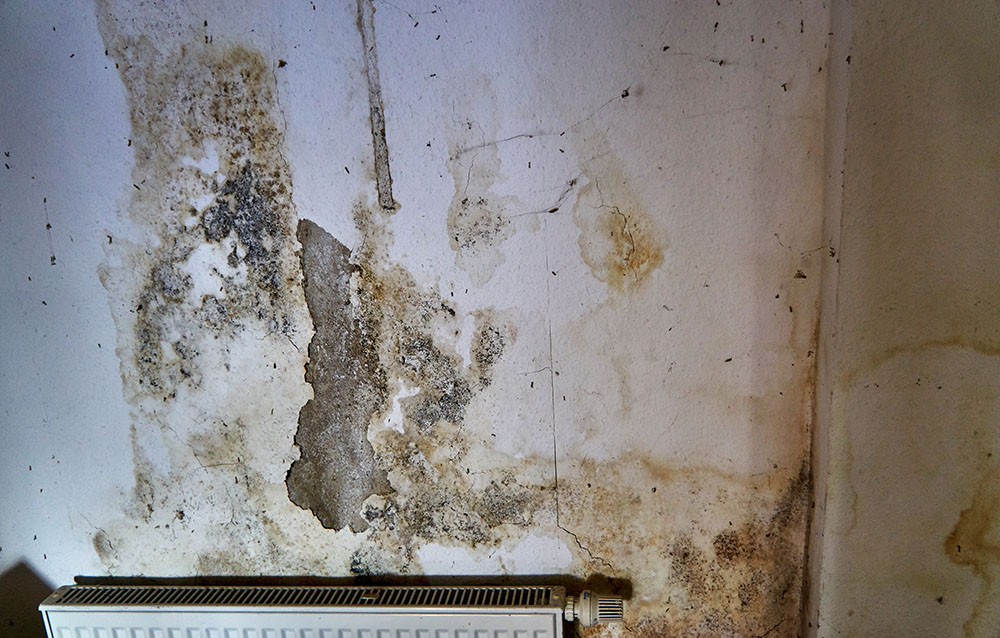When Does Mould Become Dangerous?

CONTENTS
- Understanding the nature of mould
- The life cycle of mould and how it becomes dangerous
- The health risks associated with mould exposure
- The role of quantity in mould-related hazards
- The significance of mould location in determining danger
- Identifying dangerous mould in your home
- Preventative measures against mould growth
- The impact of mould on property value
- Frequently asked questions
- Get in touch
Sometimes an unsightly patch of black, green or white mould in your home is more dangerous than expected. Mould is an unseen but potentially harmful fungal growth that can quickly spread across your home, inflicting structural damage and negative health effects.
At ICE Cleaning, we are leading the way for mould remediation across the UK. Our mould cleaning services are thorough and effective, and our technicians can identify the type of mould in your home and its level of danger.
Read on to learn more about hazardous moulds lurking in your house and what preventative measures can help.
Understanding the nature of mould
Mould is a fungus that flourishes in humid, warm settings and reproduces through spore dispersal. Mould spores are everywhere: in the air we breathe, and on many surfaces we touch, making mould such a common occurrence.
The problem starts when these spores find a suitable environment to grow, such as damp walls or leaking pipes. They begin to multiply rapidly, forming colonies that we see as visible mould growth.
There are various types of mould, like Aspergillus, Penicillium and Stachybotrys (also known as black mould). Each has its own characteristics, but all require the same things to thrive: moisture, warmth, and dead organic material to feed off.
The life cycle of mould and how it becomes dangerous
Understanding the life cycle of mould, which includes hyphae growth, spore formation, spore dispersal, and spore germination, is crucial in assessing its potential danger.
Hyphae growth
The initial stage of the mould life cycle begins with hyphae cell growth, which takes place on a damp surface.
This happens when hyphae release enzymes to break down organic matter to consume, forming a mycelium - a large fungal colony. The matter it consumes is often dead human skin, insect waste, and dirt.
Spore formation
In the second phase, spore development, the mycelium produces microscopic particles called spores. Spores rely heavily on the resources required to germinate, including light, oxygen, and warmth. Without these, the life cycle will stop, and the spores die out.
Spore dispersal
Once the conditions are met, the spores disperse and travel through air or water, depending on their location. They travel to find damp surfaces and can remain dormant for many years if required.
Spore germination
In its final stage - reproduction - once landing on another suitable surface which is damp and nutrient-rich, these dormant spores will start producing new cells, thus starting a new colony elsewhere on your property.
Prolonged exposure to significant amounts of certain types of mould over weeks or months can pose health risks, including respiratory issues.
Understanding how quickly this process occurs helps you gauge whether to take immediate action for removal or if preventative measures would suffice at an earlier time.
Preventative measures such as reducing humidity levels, improving ventilation and regular cleaning can significantly reduce the chances of mould becoming a hazard in your home.
The health risks associated with mould exposure
Exposure to mould can pose significant health risks. People sensitive to moulds may experience throat irritation, coughing or wheezing, eye irritation, and in some cases, skin irritation. There is also a risk that people with allergies or asthma might have more severe reactions.
Prolonged exposure could even lead to more serious conditions such as mould-induced asthma. Studies over the years have revealed that children living in mould-infested homes could be at risk of developing asthma before they turn seven.
The role of quantity in mould-related hazards
Quantity matters for mould growth. A small patch may cause minimal harm, but as the infestation grows, so does the risk. More mould spores mean more potential for inhaling these harmful particles.
This does not mean that a smaller amount is not dangerous; certain types of toxic moulds, even in minor quantities, can be hazardous. But typically, larger volumes are associated with greater health risks, such as respiratory issues and allergic reactions.
Mould removal is essential regardless of its size. If you notice an infestation starting to grow or persist after initial cleaning attempts, seek professional help immediately.
The significance of mould location in determining danger
Mould can lurk anywhere, but some spots are more dangerous than others. Damp basements and bathrooms often harbour mould growth, as do poorly ventilated kitchens. These areas offer the moisture that mould needs to thrive and are also places we frequent daily.
Basement mould is particularly worrying because it is easily overlooked, yet can quickly spread to other parts of your home through air ducts or walls. This rapid growth makes basement mould a potential health hazard.
In contrast, bathroom and kitchen moulds tend to be visible and thus easier to address promptly. However, window sills that often accumulate condensation here create an ideal environment for mould growth.
Identifying dangerous mould in your home
Mould identification is not always straightforward, but knowing the signs can help you take swift action. Identifying mould by appearance can be the first step in determining its presence.
Some dangerous moulds like Stachybotrys chartarum, or black mould, are a dark green-black and have a slimy texture.
Secondly, an unusual musty odour is often indicative of hidden mould colonies. If you detect such smells without an obvious source, it may be worth investigating more closely.
Lastly, recurrent health symptoms such as sneezing fits, or chronic coughs could suggest the presence of mould. If you have suspicions, you can contact a professional mould removal company to conduct a damp survey and find where the mould may be.
Preventative measures against mould growth
Controlling moisture levels in your home is crucial to prevent mould growth. At the first sign, you should fix any leaks promptly and use dehumidifiers in damp areas. Ensure rooms are well-ventilated, especially kitchens and bathrooms — you can install extractor fans or open windows regularly.
Clean regularly, including hidden areas like the back of cupboards or under sinks. You can use mould cleaner products in vulnerable areas to prevent surface growth and kill any lingering spores.
Maintain good insulation to reduce condensation on cold surfaces such as windows or walls. Additionally, properly maintain gutters and drains to avoid water accumulation near your property's foundations.
Dealing with existing mould infestations can be daunting, but knowing the right steps can help you navigate this task effectively. It is essential to evaluate the degree of the problem. DIY methods might work in a small area, less than one square meter, and on surface-level growth.
However, for larger areas or if black mould is involved, it is safer and more effective to hire professionals. Even with surface mould, we recommend wearing protective clothing when dealing with any mould type.
Ensure you cover your skin and wear a mask that covers your nose and mouth when cleaning surface-level mould.
The impact of mould on property value
Mould can significantly decrease a property's value. It will make the house unsafe and unpleasant, and potential buyers may also worry about health risks associated with mould exposure.
Furthermore, treating a serious mould problem can be costly and time-consuming, factors that could further discourage prospective buyers. According to Michael Patterson, Managing Director of WeBuyAnyHouse, mould issues can devalue a property by 20%.
This highlights why regular inspections for early detection are crucial in maintaining your home's value. Timely remediation not only prevents negative health effects but protects your investment too.
Frequently asked questions
Is mould dangerous to your health?
Yes, prolonged exposure to certain types of mould can lead to health issues like allergies, asthma attacks, and in severe cases even lung infections.
Is it dangerous to breathe in mould?
Breathing in mould spores can cause respiratory problems. It's especially harmful for those with weakened immune systems or pre-existing conditions such as asthma.
How can I tell if mould is dangerous?
Determining danger is not just about type but also quantity and location. However, black mould - Stachybotrys chartarum - is typically associated with more serious health risks.
Get in touch
Mould removal services at ICE Cleaning are some of the best in the UK. We are paving the way for modern solutions, working closely with your local council to ensure housing in your area remains safe and mould-free.
Our customer service team are available to assist 24/7, 365 days a week, including bank holidays. You can reach us at 0208 066 0360 or enquiries@icecleaning.co.uk, and we can be on-site within a few hours in an emergency, no matter where you are in the UK.

Speak with me today,
I’m here to help
By asking you a few questions either via phone or email I can immediately provide a realistic estimation of the cost.
You’re in good company. We’ve cleaned for the following commercial clients… View all

Why choose us?
- Cater to a wide variety of cleaning situations
- Nationwide coverage, available 24/7
- Cater to commercial and domestic clients
- Free survey provided prior to quotation
- Emergency response team
- Offer a bespoke service designed to suit all your needs
- All technicians hold professional health and safety qualifications, including BICSc, IOSH, Dewpoint Professional & Safe Contractor
We’re fully accredited
We place best practise, professional expertise and health and safety at the core of our business. We’re fully compliant with all legal obligations. You can view a list of our accreditations below, or visit our Health & Safety page for more information.











-RGB-small.1707319151.jpg)




















